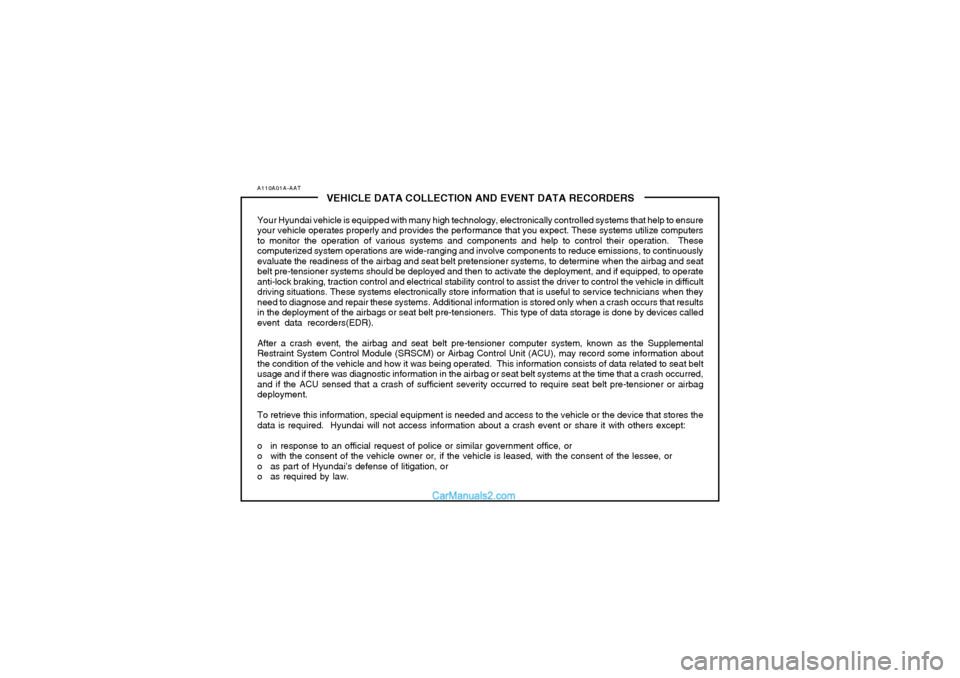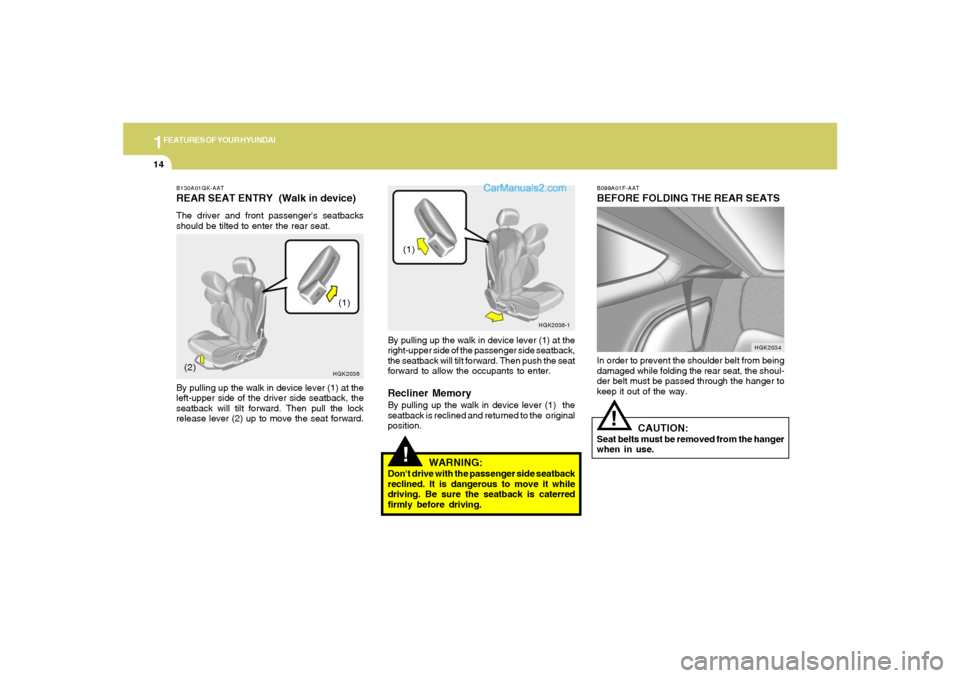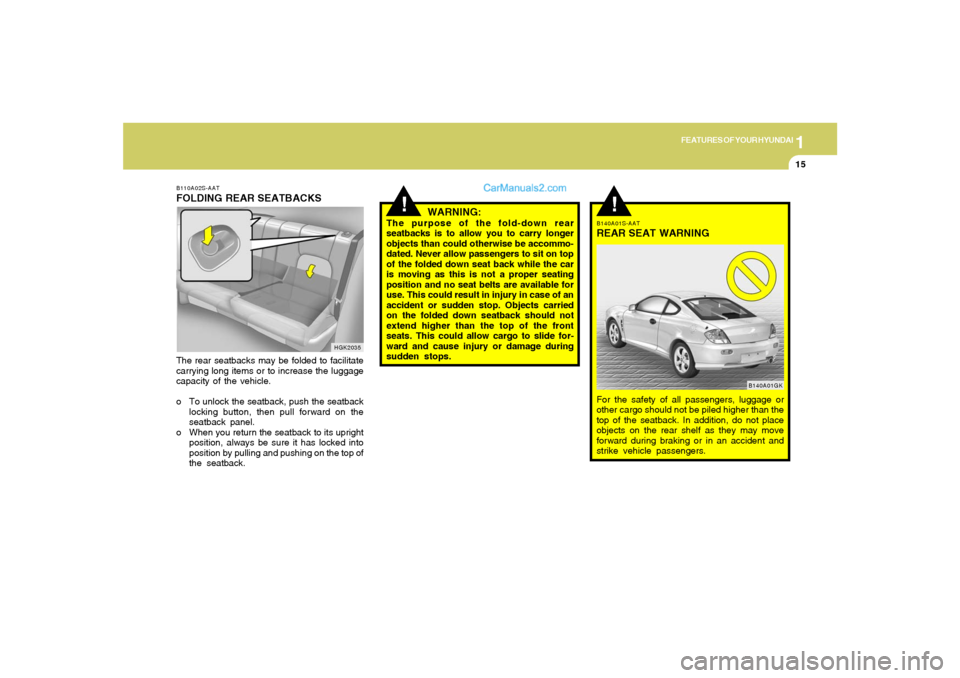2006 Hyundai Tiburon belt
[x] Cancel search: beltPage 6 of 266

A110A01A-AAT
VEHICLE DATA COLLECTION AND EVENT DATA RECORDERS
Your Hyundai vehicle is equipped with many high technology, electronically controlled systems that help to ensure
your vehicle operates properly and provides the performance that you expect. These systems utilize computers
to monitor the operation of various systems and components and help to control their operation. These
computerized system operations are wide-ranging and involve components to reduce emissions, to continuously
evaluate the readiness of the airbag and seat belt pretensioner systems, to determine when the airbag and seat
belt pre-tensioner systems should be deployed and then to activate the deployment, and if equipped, to operate
anti-lock braking, traction control and electrical stability control to assist the driver to control the vehicle in difficult
driving situations. These systems electronically store information that is useful to service technicians when they
need to diagnose and repair these systems. Additional information is stored only when a crash occurs that results
in the deployment of the airbags or seat belt pre-tensioners. This type of data storage is done by devices called
event data recorders(EDR).
After a crash event, the airbag and seat belt pre-tensioner computer system, known as the Supplemental
Restraint System Control Module (SRSCM) or Airbag Control Unit (ACU), may record some information about
the condition of the vehicle and how it was being operated. This information consists of data related to seat belt
usage and if there was diagnostic information in the airbag or seat belt systems at the time that a crash occurred,
and if the ACU sensed that a crash of sufficient severity occurred to require seat belt pre-tensioner or airbag
deployment.
To retrieve this information, special equipment is needed and access to the vehicle or the device that stores the
data is required. Hyundai will not access information about a crash event or share it with others except:
o in response to an official request of police or similar government office, or
o with the consent of the vehicle owner or, if the vehicle is leased, with the consent of the lessee, or
o as part of Hyundai’s defense of litigation, or
o as required by law.
Page 12 of 266

YOUR VEHICLE AT A GLANCEB255A02GK-AATINDICATOR SYMBOLS ON THE INSTRUMENT PANEL* More detailed explanations of these items will be found beginning on page 1-38.
Malfunction Indicator LightSRS (Airbag) Service Reminder Indicator (SRI) Tail Gate Open Warning Light
Low Fuel Level Warning LightDoor Ajar Warning Light and ChimeABS Service Reminder Indicator (SRI) (If installed)Turn Signal Indicator LightsHigh Beam Indicator Light
Low Oil Pressure Warning Light
Parking Brake/ Low Brake Fluid Level Warning Light
Charging System Warning LightCRUISE Indicator Light (If installed)
Seat Belt Reminder Light and Chime
CRUISE SET Indicator Light (If installed)
Electronic Stability Program (ESP)
Indicator Lights (If installed)
Page 13 of 266

FEATURES OF YOUR HYUNDAI
1
Fuel Recommendations ................................................ 1-2
Breaking in Your New Hyundai ..................................... 1-3
Keys.............................................................................. 1-3
Door (Teft-Alarm System) ...................................... 1-4, 1-6
Power Windows ............................................................ 1-9
Seats...........................................................................1-10
Seat Belts....................................................................1-16
Child Restraint System ...............................................1-21
Supplemental Restraint (AIRBAG) System (SRS) .....1-28
Instrument Cluster and Indicator Lights...................... 1-36
Warning and Indicator Lights......................................1-38
Multi-Function Light Switch .........................................1-47
Windshield Wiper/Washer Switch...............................1-49
Sunroof.......................................................................1-55
Mirror...........................................................................1-58
Hood Release .............................................................1-61
Cruise Control.............................................................1-67
Audio Remote Control Switch .....................................1-70
Heating and Cooling Control .......................................1-71
Stereo Sound System.................................................1-88
Audio System..............................................................1-90
Antenna.....................................................................1-127
1
Page 16 of 266

1FEATURES OF YOUR HYUNDAI4
WARNING:
o Unlocked doors can be dangerous. Be-
fore you drive away (especially if there
are children in the car), be sure that all the
doors are securely closed and locked so
that the doors cannot be inadvertently
opened from the inside. This helps en-
sure that the doors will not be opened
accidentally. Also, when combined with
the proper use of seat belts, locking the
doors helps keep occupants from being
ejected from the car in case of an acci-
dent.
o Before opening the door, always look for
and avoid oncoming traffic.
o In case of accident, the door is unlocked
automatically (If installed).
!DOORB040A02Y-AATDOOR LOCKS
B030C01Y-AATILLUMINATED IGNITION SWITCH
(If installed)Whenever a door is opened, the ignition switch
will be illuminated for your convenience, pro-
vided the ignition switch is not in the "ON"
position.
The light will go off approximately 10 seconds
after closing the door or when the ignition switch
is turned on.
B030C01E-1
B030B01S-AATRecord Your Key NumberA code number is stamped on the key number
plate that came with the keys to your Hyundai.
This key number plate should be kept in a safe
place, not in the vehicle. The key number should
also be recorded in a place where it can be found
in an emergency.
If you need additional keys, or if you should lose
your keys, your authorized Hyundai dealer can
make new keys if you can supply the key
number.
B030B01E
Page 24 of 266

1FEATURES OF YOUR HYUNDAI12
!
B080D01JM
o For maximum effectiveness in case of an
accident the headrest should be ad-
justed so the middle of the headrest is at
the same height as the top of the
occupant's eyes. For this reason, the
use of a cushion that holds the body
away from the seatback is not recom-
mended.
o Do not operate vehicle with the head-
rests removed as injury to the occupants
may occur in the event of an accident.
Headrests may provide protection against
neck injuries when properly adjusted.
o Do not adjust the headrest hejght while
the vehicle is in motion.
WARNING:
!
WARNING:
Riding with a reclined seatback increases
your chance of serious or fatal injuries in
the event of a collision or sudden stop. The
protection of your restraint system (seat
belts and airbags) is greatly reduced by
reclining your seat. Seat belts must be snug
against your hips and chest to work prop-
erly. The more the seatback is reclined, the
greater the chance that an occupant's hips
will slide under the lap belt or the occupant's
neck will strike the shoulder belt. Drivers
and passengers should always sit well back
in their seats, properly belted, and with the
seatbacks upright.
B080D02JM-AATAdjustable HeadrestsHeadrests are designed to help reduce the risk
of neck injuries.
To raise the headrest, pull it up. To lower the
headrest, push it down while pressing the lock
knob. To remove the headrest, raise it as far as
it can go then press the lock knob while pulling
upward. This should only be done when the seat
is not occupied.Lock Knob
HGK2032
Page 25 of 266

1
FEATURES OF YOUR HYUNDAI
13
B080F01F-AATSeat Cushion Height Adjustment
(Driver's Seat Only) (If Installed)To raise or lower the front part of the seat
cushion, turn the knob forward or rearward.
HGK2029
B080E01F-AATLumbar Support Control
(Driver's seat only)The driver's seat is equipped with adjustable
lumbar support.
To increase the amount of lumbar support, pull
the lever forward.
To decrease it, push the lever toward the rear.SOFT
HGK2030
FIRM
!
B129A01F-AATREAR SEAT POSITIONS
WARNING:This vehicle contains two rear seating po-
sitions only and a seat belt for each seating
position. Thus, never permit more than two
occupants to ride in the rear seat because
an unrestrained occupant could be seri-
ously injured or killed in the event of a
vehicle crash.
B129A01GK
Page 26 of 266

1FEATURES OF YOUR HYUNDAI14
B099A01F-AATBEFORE FOLDING THE REAR SEATSIn order to prevent the shoulder belt from being
damaged while folding the rear seat, the shoul-
der belt must be passed through the hanger to
keep it out of the way.
CAUTION:
Seat belts must be removed from the hanger
when in use.
!
HGK2034
B130A01GK-AATREAR SEAT ENTRY (Walk in device)The driver and front passenger's seatbacks
should be tilted to enter the rear seat.
By pulling up the walk in device lever (1) at the
left-upper side of the driver side seatback, the
seatback will tilt forward. Then pull the lock
release lever (2) up to move the seat forward.
HGK2036(1)
(2)
!
By pulling up the walk in device lever (1) at the
right-upper side of the passenger side seatback,
the seatback will tilt forward. Then push the seat
forward to allow the occupants to enter.Recliner MemoryBy pulling up the walk in device lever (1) the
seatback is reclined and returned to the original
position.
WARNING:
Don't drive with the passenger side seatback
reclined. It is dangerous to move it while
driving. Be sure the seatback is caterred
firmly before driving.
HGK2036-1
(1)
Page 27 of 266

1
FEATURES OF YOUR HYUNDAI
15
!
WARNING:
The purpose of the fold-down rear
seatbacks is to allow you to carry longer
objects than could otherwise be accommo-
dated. Never allow passengers to sit on top
of the folded down seat back while the car
is moving as this is not a proper seating
position and no seat belts are available for
use. This could result in injury in case of an
accident or sudden stop. Objects carried
on the folded down seatback should not
extend higher than the top of the front
seats. This could allow cargo to slide for-
ward and cause injury or damage during
sudden stops.
B110A02S-AATFOLDING REAR SEATBACKSThe rear seatbacks may be folded to facilitate
carrying long items or to increase the luggage
capacity of the vehicle.
o To unlock the seatback, push the seatback
locking button, then pull forward on the
seatback panel.
o When you return the seatback to its upright
position, always be sure it has locked into
position by pulling and pushing on the top of
the seatback.
HGK2035
!
B140A01S-AATREAR SEAT WARNINGFor the safety of all passengers, luggage or
other cargo should not be piled higher than the
top of the seatback. In addition, do not place
objects on the rear shelf as they may move
forward during braking or in an accident and
strike vehicle passengers.
B140A01GK